Advanced application
Two persons may choose a different grip on the same goal
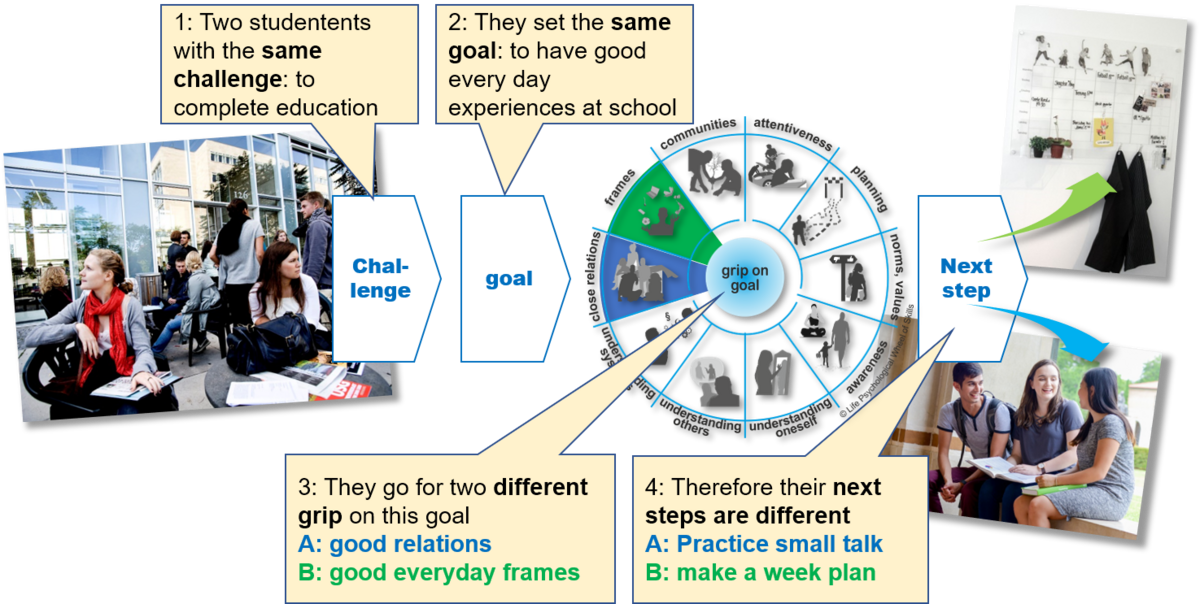
An example
Two students may experience the same challenge: to complete the education they have just started on. They may also have the same goal: to succeed and complete their education they need to thrive in their everyday life at school. To student A, this means having a few good friends to hang out with at school. She therefore chooses the relation skill to achieve her goal. She uses this skill to set her next step: practicing small talk about, for example, popular series on streaming channels. To student B, the same goal means something different, namely to have good frames and priorities in her everyday life. She therefore chooses to achieve her goal by means of the framing skill. Accordingly, her next step is to buy a whiteboard and start making a week plan.
The Life Psychological method in depth

In the Wheel of Skills, each life skill is so to speak a window one can open to have a greater outlook on life as well as to get a deeper insight.
Let us have a look at an example of a young girl who wants to improve her social life at school. Together with her school counselor, she may use the Life Psychological method and the 360-degree tool to get a deeper insight into the life task of building close relationships and to empower the general relation life skill (in principle she may work in depth with all ten life skills).
1: The immediate situation. The young girl and her counselor may start out by mapping her present social network. Maybe her plan is to expand her social network to include her peers at school as well.
2: Proactivity and motivation. They may go a step further, that is, to use the BFL tool and the five basic questions to look at whether she does in fact want to have new friends at school? Is she able to use her relation skill? Are the necessary external conditions for building relations available? Will she be met by others when reaching out? Does she in fact set a realistic and motivating next step towards her goal? Maybe she should have a closer look at which of the five aspects of proactivity she may need to empower?
3. Basic model of the world. Perhaps taking the in-depth analysis even further by looking at her basic conceptions, narratives and social cognitive models of a good enough social life? Maybe her conceptions and prospection should be changed?
4: Personality. An even deeper analysis may reveal that pronounced introversion and shyness may be characteristic of her personality structure so that she basically does not thrive with too extensive social contacts and social life. Maybe her life history reveals that she has never been met adequately in accordance with her fundamental traits, and therefore she ended up having disordered models about a normal and perfect social life not fitting her own personality and feelings? Maybe she must be helped coming to peace with her basic personality structures (and life history) so that she prospectively may become able to use her relation skill (and her other general life skills) in a personally meaningful way.
S.M.A.R.T goals and useful life skills
S.M.A.R.T. An additional quality of a goal is whether it meet the five S.M.A.R.T. criteria. Below you will find the five criteria and some help questions one can ask to check whether the goal is well set. If one or more of these criteria has not been met, then try to rephrase the goal.
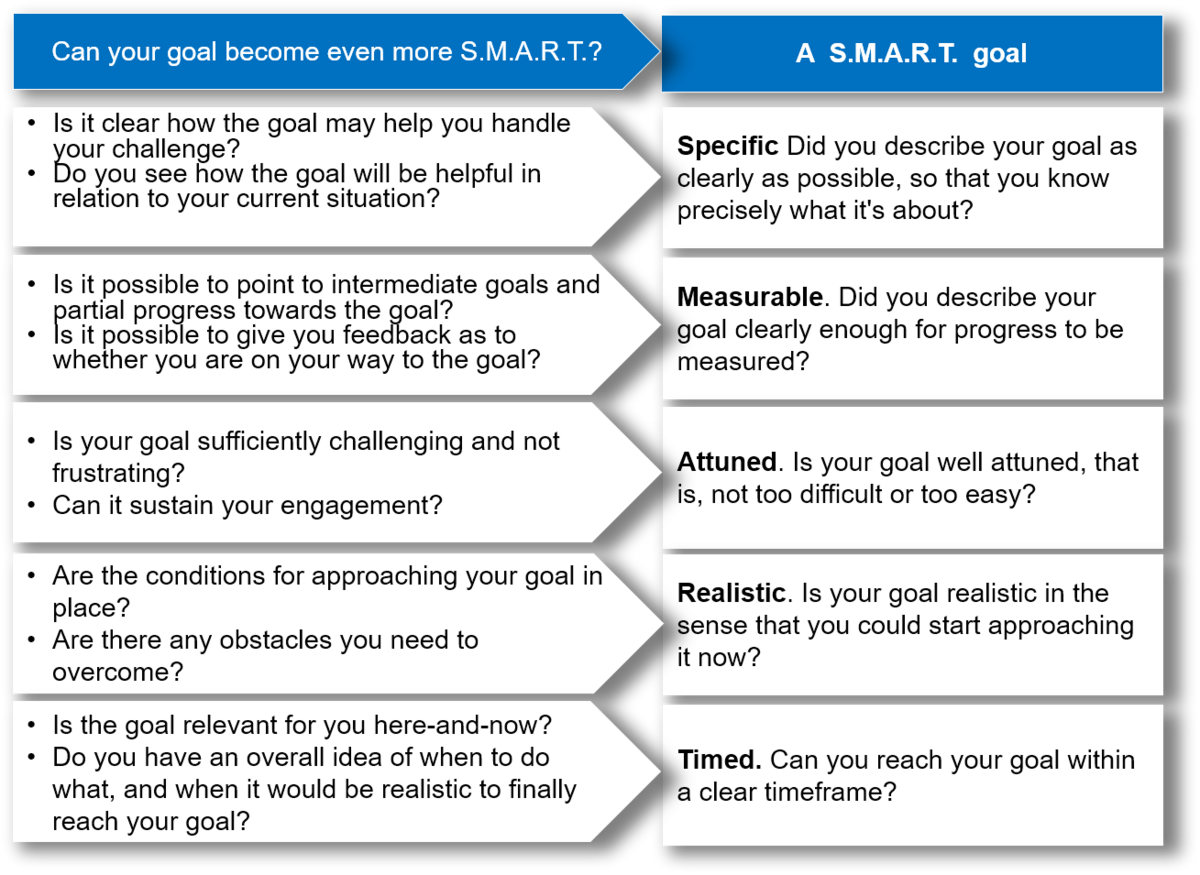
Usability. A well set goal should be meaningful, it should be phrased in your own words and you should have a good idea of what you can do yourself to reach it. If it is not meaningful, comprehensible and manageable, then try to re-set the goal to something which meet these three criteria.
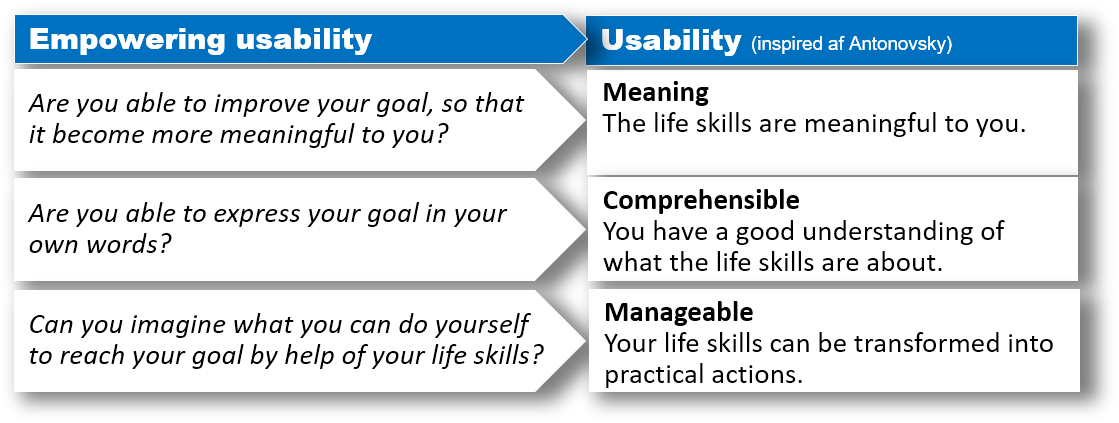
Proactivity, personal responsibility, and community
Life skills may be used in different ways in different situations and according to different major life projects. The use of life skills is characterized as either high or low degrees of proactivity, taking responsibility, and community orientation.

Life skills used in a proactive way. First, the use of life skills is characterized by some degree of proactivity. This degree can be assessed with the BFL tool.
A positive development in the way the skills are utilized is indicated by increasing proactivity (from red to green). See below how to work with proactivity.

Life skills used in a personal responsible way. Second, the use of life skills is characterized by personal responsibility for how they are used and transformed into actions.
An increasingly higher score when it comes to acknowledging personal responsibility for transforming skills into actions and behaviour is an indication of positive development. See below how to work with personal responsibility.
The figure to the left illustrates the combination of proactivity and taking responsibility; it shows, for example, that in some cases the utilization of life skills may be low on both proactivity and taking responsibility (red). In other cases, proactivity may be high, yet taking responsibility for one’s activities may be low (yellow). A positive development in the way the skills are utilized is indicated by increasing both proactivity and personal responsibility (green).

Life skills used in a community-oriented way. Third, the use of life skills and their transformation into handling challenges and achieving goals is characterized by degree of constructive directedness towards the societal community.
Here, positive development will be indicated by the fact that the utilization of life skills has positive and constructive consequences for the community. See below how to work with community orientation.
When community orientation is combined with proactivity and taking responsibility, the three-dimensional figure on the left emerges. In some cases, utilization of life skills will be characterized as low in all three dimensions (red). In other cases, the way in which life skills are utilized to handle life tasks and challenges is in fact characterized by high degrees of both proactivity and taking personal responsibility for how they are transformed into goal-directed actions. They may, however, be very low on community orientation or even destructive to community; exemplified by for example extremism, extreme self-centeredness and individualism, or political and/or religious extremism.
A positive development would be indicated by a high degree of communitive orientation, i.e., affirmatively or constructive-critically directed at the societal community (green).
The three dimensions integrated
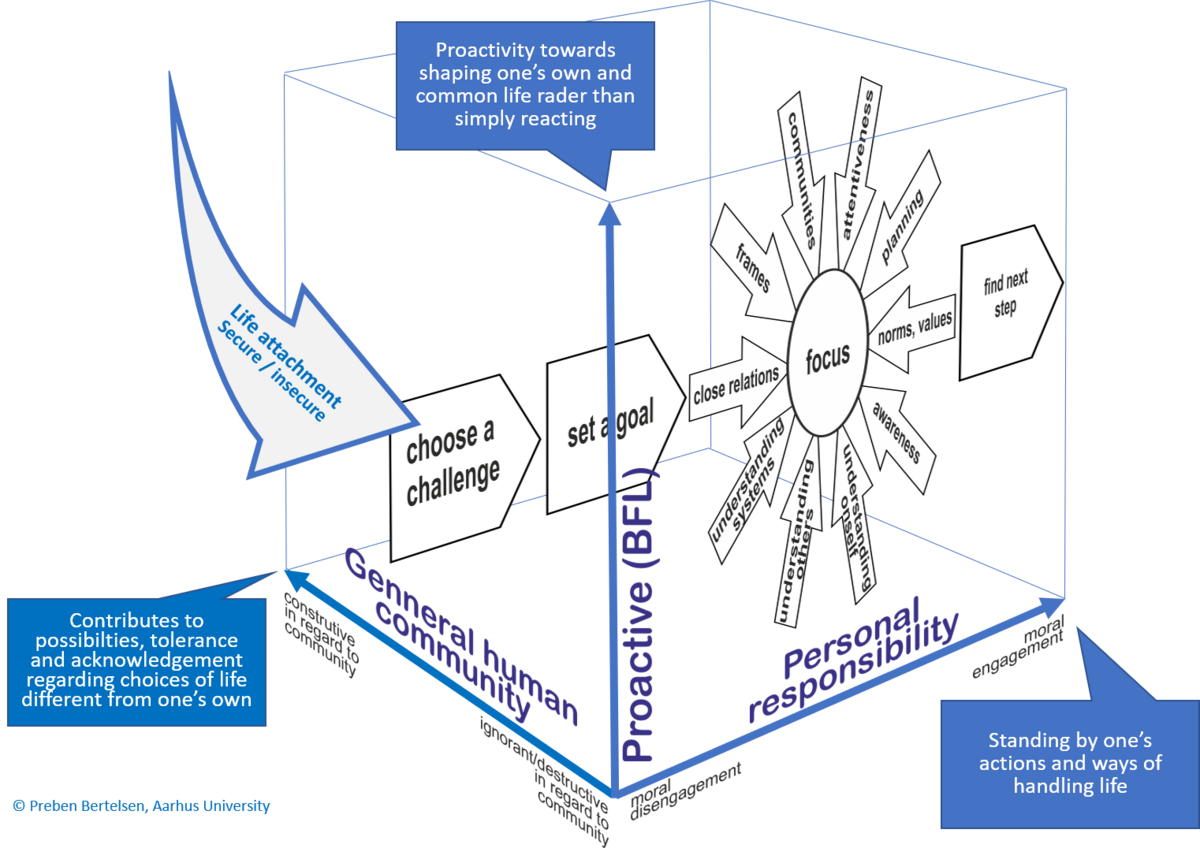
The following figure shows, how the way in which the tools are used is determined by (1) the degree of proactivity, (2) the degree of personal responsibility and (3) by the fact that what ever we do to handle own life always has some effect on the general human community.
Furthermore, the figure shows that in terms of Life Psychology a basic trait of a good enough life is, that one experience life and the world as a good place to be. In Life Psychology this is termed secure life attachment.
Secure life attachment is the experience of life as based on human coexistence, and that life is reliable, safe, characterized by integration and inclusion, as well as the freedom to participation and deliberation. The opposite is insecure life attachment, that is, one experience life as lacking one or more of these qualities.
In terms of Life Psychology maintaining secure life attachment – or restoration of secure life attachment if it has been threatened, even lost – is a basic life challenge.
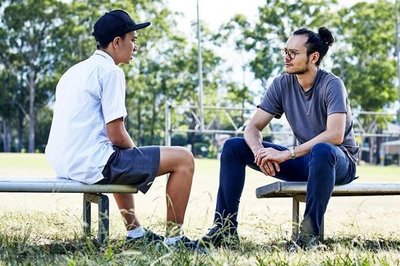
Below you will find some suggestions concerning how to challenge and improve the way life skills are used to handle life tasks and achieving goals.
1: Suggestions regarding proactivity
Using life skills in a proactive way means to act to change something and not merely wait for changes to occur and then react to them.
The BFL-tool (Basic Five of Life Psychology) has been developed to empower life skill proactivity and is an integrated part of the tools found in the app.
Each of the five basic questions can be used for assessment of aspects of proactivity. Each aspect is independent of the other aspects, i.e., the answer to one question is independent of answers to the other questions.
For example, one may want to use a given life skill to manage a life task, and one may be able to use this skill. However, at the same time, one may not be able to recognize which external conditions and possibilities are necessary for one’s activity to succeed. Furthermore, one may not be met by others, that is, one may not be able to acknowledge or accept help and support from others. As a consequence, proactivity as such may decrease. Conversely the external conditions may be perfect and one is being met by others, and even has the will to act, but one does not know exactly how or lack some knowledge or information to put one’s skill into action - in which case the overall proactivity may decrease.
All in all, each of the five aspect should be empowered to increase the overall proactivity.
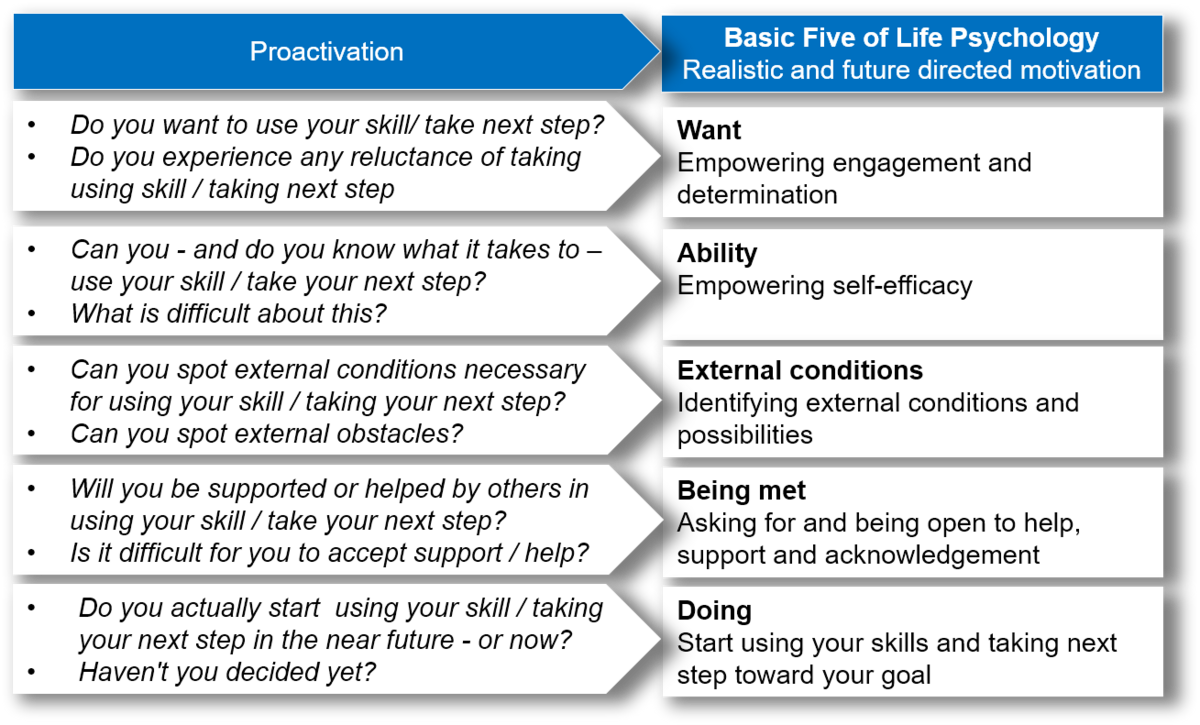
2: Suggestions regarding taking responsibility
To be morally engaged in the way life skills are to handle life tasks and challenges, that is, take responsibility for actions and behaviour. In some cases, a person may, however, act in a way characterized by moral disengagement and may decline on taking responsibility for his or her actions. For example, a driver’s excuse for violating the speed limit could be that all the other drivers in the queue, he/she was caught in, were driving too fast: “Go with the flow”. Or, a soldier may excuse cruelty or war crime in combat by saying he was just obeying orders.
Social Psychology describes seven such types of moral disengagement. That may be the cause of individual decline on taking responsibility (Bandura **, see the figure). Correspondingly, Life Psychology describes eight responses by means of which moral disengagement can be counteracted and ability to take responsibility empowered (see the arrow-shaped boxes in the figure).
All in all, moral disengagement should be counteracted and capability of taking responsibility for way of using life skills empowered.
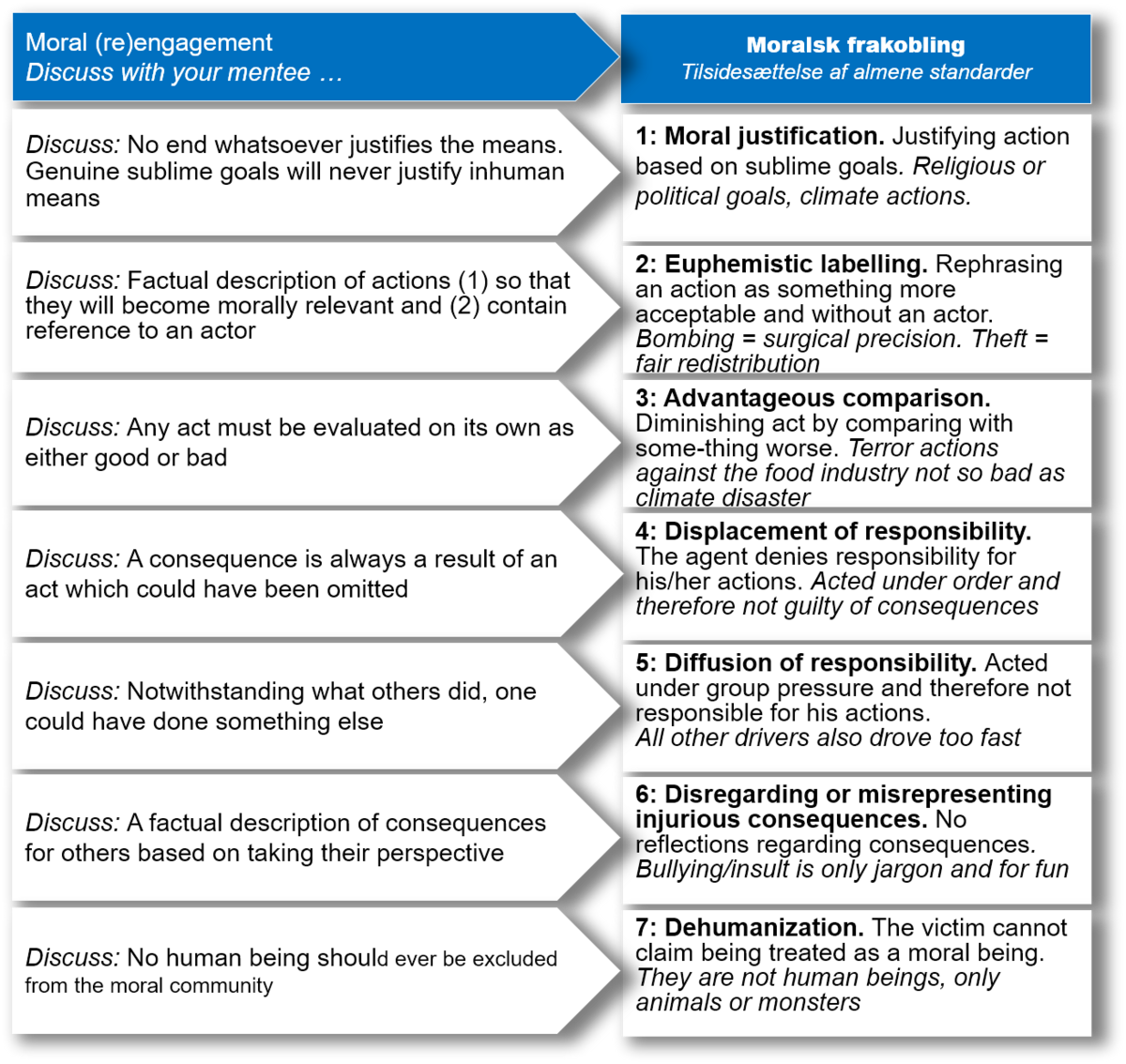
3. Suggestions regarding general human community
The general human community is the foundation on which every one of us – also people who differs from us – may establish the way of life in which we thrive and prosper.
In terms of Life Psychology the general human community is created, maintained and developed based on recognition and tolerance.
Recognition: Recognition means that one is significant to others and that one behave and acts in such ways that others experience significance. As Honneth has argued recognition is important in three domains. (1) The private domain: Recognition is about being met with affection and love by family and friends. The opposite of recognition is being abused. In this domain: being met by lack of care, emotional distancing, humiliation, insults or racism. (2) The domain of justice: Having equal rights and being met by fairness. Not being met by recognition in this domain is about (de jure and/or de facto) not having access to the same rights as others. (3) The domain of solidarity. Recognition of the societal contributions one is willing to and able to give to the common goods. Not being recognized in this domain is about others flattening or not valuing one’s contributions to the general human community.
Tolerance: Recognition is necessesary but not sufficient to maintain and develop the general human community. Recognition may in principle be restricted to one’s own “ingroup” and denied to “outgroups”. Tolerance takes it point of departure in the fact people (individuals, groups, social and ethnic segments, nations) prefer different ways of life. That is, tolerance is defined by diversity. Tolerance is the ability to accept and provide social, cultural and societal space for others having ways of life different from one’s own.
In shot: this dimension is about empowering life skills as (in consequence) directed at the maintenance and critical-constructive development of general human community
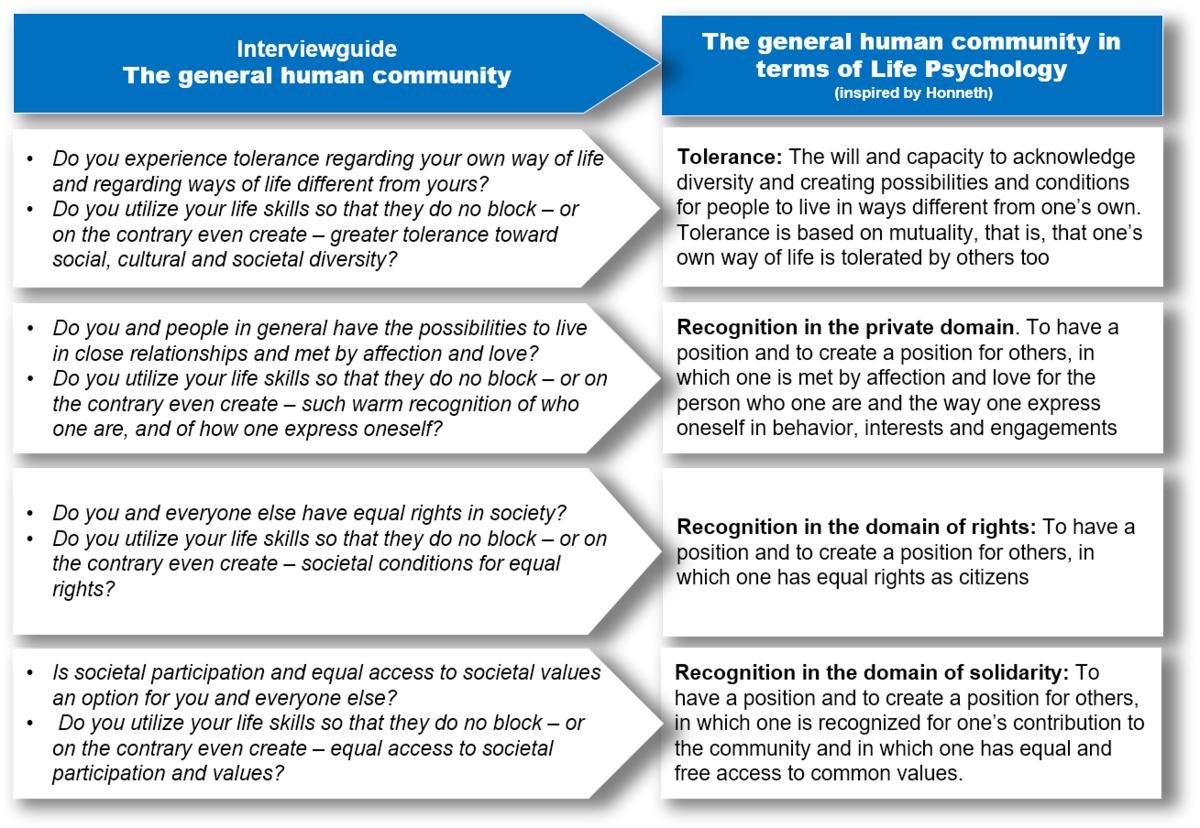
4. Suggestions regarding secure life attachment
In terms of Life Psychology, it is a basic general human life task and challenge to care for one’s own and common life attachment. Secure life attachment is the experience of the life and the world as a good place to be.
In Life Psychology secure life attachment is defined by 7 characteristics:
- Co-existence: Basically, we are social beings. First we would not be able to live a human life if we did not work together in creating, maintaining and developing the common material foundation (food, housing, a nontoxic environment, tools, cultural artefacts, societal infrastructure, institutions etc). Second, feeling at home in societal networks and the experience of belongingness is a basic human need. We have a basic need of being valued, met with affection, loved, recognized and feeling significant to others. In short: we are co-existential beings.
- Reliability: Experience of community as a stable basis for own and common life. Utilization of life skills is constructively directed at maintaining community as stable
- Security/safeness: Experience of community as provider of security and safeness. Utilization of life skills is constructively directed at maintaining security and safeness
- Integration: Experience of equality and fairness regarding access to institutions, positions and benefits of the societal community. Utilization of life skills in a way that contributes to maintenance of the societal institutions, positions and benefits of the societal community
- Inclusion: Experience of being acknowledged by community and experience of community as “us”. Utilization of life skills contributes constructively in maintaining community as inviting, containing and tolerant with regard to containing human and cultural diversity
- Participation: Experience of engagement regarding one or more aspects or institutions of community. Utilization of life skills is constructively operationalized as engagement in vital institutions or aspects of community
- Deliberation: Experience of deliberation as the primary method to manage tasks and challenges in community. Utilization of life skills includes deliberation regarding management of diversity, otherness and conflicts.
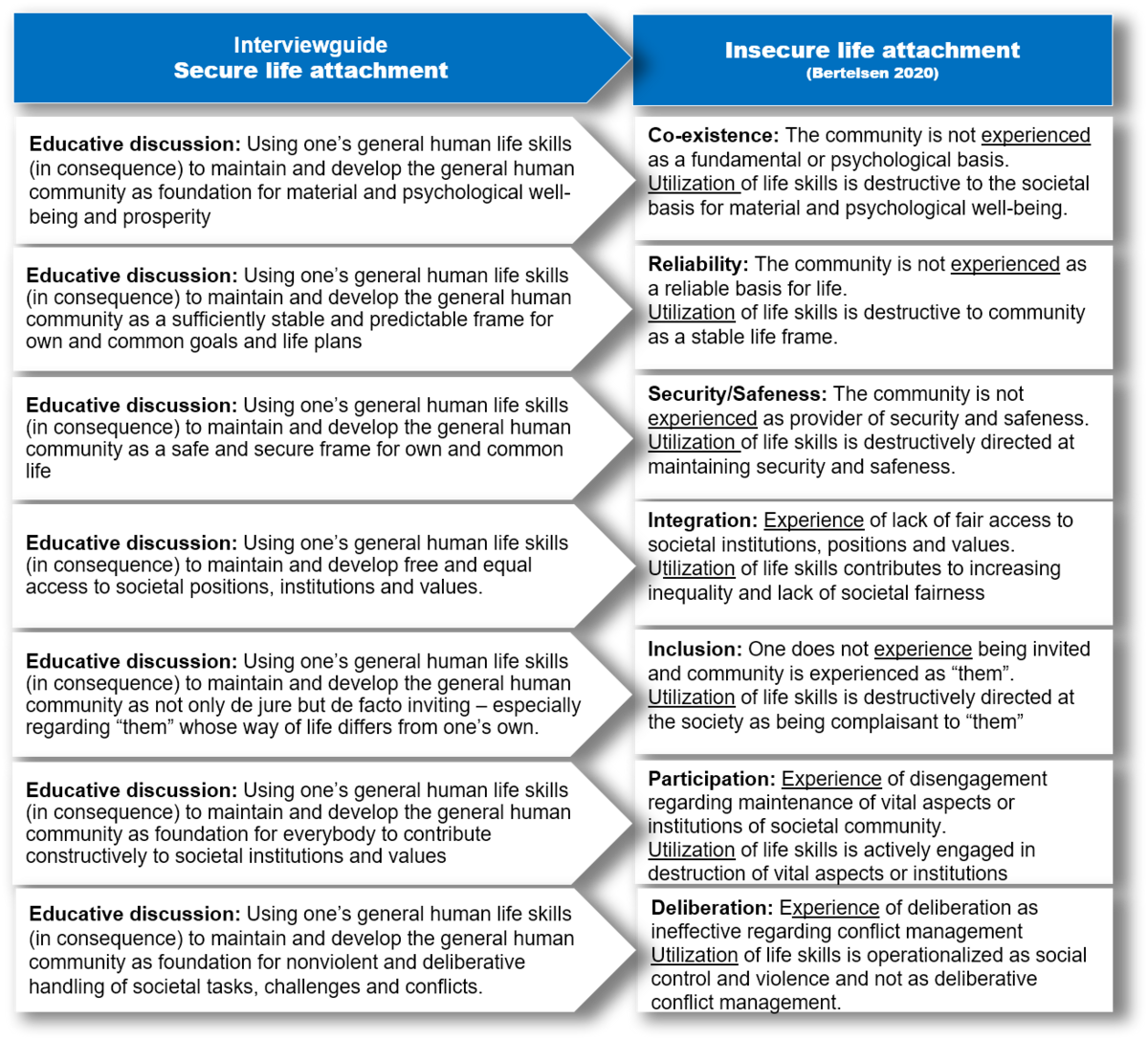
Education, Counseling, supervision, preparing intervention
Teaching the method
Based on the Life Psychological approach, teachers, counsellors, mentors or therapists provide their students, mentees or clients with some new tools for comprehending and managing concrete challenges or life at large in a personally meaningful way.
Professionals can go through the tools step by step (start with the 360 degree tool and then go to the LGT tool) and help their students or clients pick up the mindset and skill set as a future way of handling particular challenges and problems as well as of getting a grip on life as such.
A tool in counselling (mentoring, therapy)
Professionals can use the tools to guide the process. Coworking with their client/mentee on how to use the tools step by step to find specific life tasks by setting a goal, identifying the best general life skill by means of which to approach the goal and transform these skills into a concrete next step towards the goal.
Professionals will then, together with their client/mentee, find ways to handle the chosen life challenge. As a next step, the client/mentee will, through continued practice with these tools learn the method as a general way of handling new challenges and future problems.
A tool in supervision
Supervisors may use the tools to find ways to comprehend challenges encountered by the supervisee in his or her work.
Case supervision. Supervisor and supervisee may take a closer look at the mentee’s or client’s challenges and problems and examine which goals, skills and next steps would be essential in making changes in his/her grip on life. Supervisor and supervisee may also discuss how learning to use the tools may help the mentee or client.
Personal supervision. Supervisor and supervisee may take a closer look at supervisee’s personal challenges and problems in relation to working with a client/mentee and his/her challenges. In this case the supervisor uses the tools to guide the supervisee through a process of setting goals, embracing relevant general life skills and setting next steps for him-/herself regarding such personal challenges and problems.
A tool in the process of preparing an intervention
Professionals may use the method and the tools on available information to prepare an intervention even before meeting with the student, client or mentee; taking into consideration what is known about the challenges in the student’s, client’s or mentee’s life and which particular challenges or problems to start dealing with. Furthermore, it may be worth considering which goals would be advisable for the student, client or mentee to set. Which general life skills would be advisable for him/her to embrace in his or her approach to the goal? How do these life skills work well? How may they be empowered? How may the next step be constructed in a motivating way – so that they will in fact be experienced as meaningful and worth the effort?
As always, such pre-set ideas must be compared with and attuned to the student’s, mentee’s or client’s own ideas of a meaningful choice of challenges as well as comprehensible and meaningful management.


